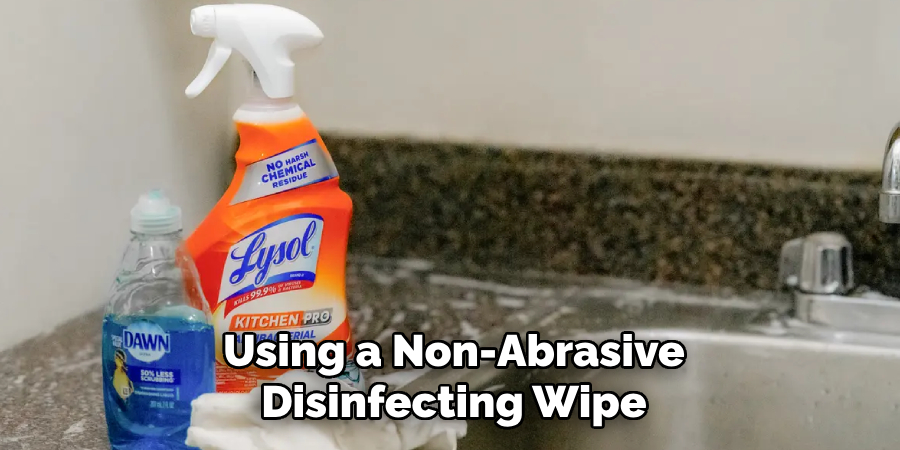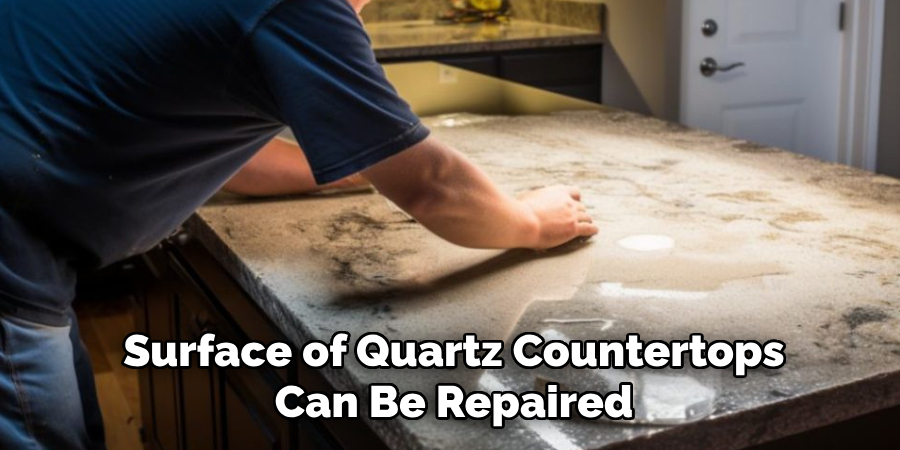Quartz countertops are a popular choice for many homes due to their durability, sleek appearance, and low maintenance requirements. However, like any surface, they require proper cleaning and sanitization to maintain their beauty and ensure a hygienic environment. Understanding how to sanitize quartz countertops can help in maintaining it properly and troubleshooting common issues that may arise over time. Knowing the right methods and products to use can help you keep your quartz countertops looking pristine while preventing damage over time.

Why Proper Sanitation is Essential for Kitchens
Proper sanitation in the kitchen is crucial for maintaining a safe and healthy environment for food preparation. Kitchens are often exposed to bacteria, viruses, and other contaminants from raw ingredients, spills, and frequent handling. Without regular cleaning and sanitization, these germs can spread, potentially leading to foodborne illnesses. Additionally, a sanitized kitchen helps prevent the buildup of grime, grease, and stains, preserving the longevity and appearance of surfaces like quartz countertops. Ensuring proper hygiene in this space creates peace of mind, knowing that the meals prepared are safe for consumption and that the environment is both clean and inviting.
Tools and Materials Needed
To properly sanitize quartz countertops, you’ll need the following tools and materials:
- Mild Dish Soap: A gentle, non-abrasive soap is ideal for cleaning without causing damage to the surface.
- Warm Water: Used to mix with soap and rinse the countertops effectively.
- Microfiber Cloths: These are soft and non-scratch, making them perfect for wiping down quartz surfaces.
- Spray Bottle (optional): Handy for mixing and applying cleaning solutions evenly.
- Non-Abrasive Sponge: Useful for tackling tougher spots without harming the countertop finish.
- Isopropyl Alcohol (70% or higher): Acts as a disinfectant to kill germs and bacteria while being safe for quartz.
- Soft-Bristle Brush (optional): Useful for cleaning around edges, seams, or textured areas.
Having these tools and materials available will ensure you can clean and sanitize your quartz countertops effectively without risking damage to their surface or luster.
10 Methods How to Sanitize Quartz Countertops
1. Daily Cleaning with Mild Dish Soap and Warm Water
One of the simplest and most effective ways to sanitize quartz countertops is by using mild dish soap mixed with warm water. Fill a spray bottle with warm water and a few drops of dish soap. Spray the solution onto the countertop and wipe it down with a microfiber cloth or soft sponge. This method helps remove daily grime, grease, and food residue without harming the quartz surface.

2. Using Isopropyl Alcohol for Deep Sanitization
For thorough disinfection, isopropyl alcohol (70% or higher) can be used to kill bacteria and viruses. Spray a small amount of isopropyl alcohol directly onto the surface and let it sit for a minute before wiping it down with a clean microfiber cloth. This method is especially useful after food preparation to eliminate germs and maintain a hygienic kitchen.
3. Disinfecting with White Vinegar and Water Solution
White vinegar is a natural disinfectant that can help sanitize quartz countertops. However, because vinegar is acidic, it should be diluted with water to prevent damage. Mix equal parts of white vinegar and water in a spray bottle, then lightly mist the countertop. Wipe with a soft cloth to remove germs and bacteria. Avoid using this method too frequently, as prolonged exposure to acidity may dull the quartz finish.
4. Cleaning with Hydrogen Peroxide for Stain Removal
Hydrogen peroxide is a gentle but effective sanitizer that also helps remove stains. Dampen a cloth with hydrogen peroxide and wipe down the surface, allowing it to sit for a few minutes. Rinse with warm water and dry with a clean cloth. This method is great for quartz countertops exposed to food spills and stains, as it removes discoloration without harsh chemicals.
5. Using a Non-Abrasive Disinfecting Wipe
Disinfecting wipes, such as those containing benzalkonium chloride, are a convenient way to sanitize quartz countertops without causing damage. Simply wipe the surface with a non-abrasive disinfecting wipe, making sure to cover all areas. This method is quick and effective, especially for high-traffic areas that require frequent sanitization.

6. Applying a Baking Soda Paste for Tough Stains
For stubborn stains, a baking soda paste can help lift dirt while sanitizing the surface. Mix baking soda with a small amount of water to form a thick paste. Apply the paste to the stain and gently scrub with a soft cloth or sponge. Let it sit for 5-10 minutes before wiping clean with a damp cloth. This method is particularly effective for removing dried spills and food stains.
7. Steam Cleaning for Chemical-Free Sanitization
A steam cleaner is a great option for deep cleaning and sanitizing quartz countertops without using any chemicals. The high temperature of the steam effectively kills bacteria and loosens grime. Move the steam cleaner nozzle across the surface evenly, then wipe dry with a clean microfiber cloth. This method is safe for quartz and provides a natural, eco-friendly way to sanitize countertops.
8. Using a pH-Balanced Quartz Cleaner
Many manufacturers produce specially formulated quartz cleaners designed to sanitize and protect the surface. These cleaners are pH-balanced to prevent damage and often contain mild disinfecting agents. Spray the cleaner onto the countertop and wipe it down with a microfiber cloth. Using a quartz-specific cleaner ensures safe and effective sanitation without dulling the surface.
9. Avoiding Harsh Chemicals and Abrasive Scrubbers
While bleach, ammonia, and abrasive cleaners may be effective for killing bacteria, they can cause irreversible damage to quartz countertops. Instead of using harsh chemicals, opt for milder disinfectants or natural solutions like alcohol and hydrogen peroxide. Additionally, avoid using scouring pads or abrasive scrubbers that can scratch the quartz surface over time.

10. Regularly Drying the Countertop to Prevent Bacteria Growth
Moisture left on quartz countertops can create an environment for bacteria and mold growth. After cleaning or sanitizing, always dry the surface with a clean microfiber cloth. This not only prevents bacterial buildup but also helps maintain the quartz’s shine and prevents water spots from forming.
Maintenance and Upkeep
Proper maintenance and regular upkeep are essential to ensure your quartz countertops remain in excellent condition for years to come. Here are some tips to preserve their beauty and functionality:
- Wipe Spills Immediately: Quartz is resistant to stains, but prolonged exposure to liquids such as wine, coffee, or oils can leave marks. Clean spills promptly with a damp cloth and mild soap to prevent any potential discoloration.
- Use Cutting Boards and Trivets: Although quartz is highly durable, using cutting boards for food preparation and trivets under hot pots or pans will help protect the surface from scratches and thermal shock.
- Avoid Direct Sunlight: Extended exposure to direct sunlight can cause quartz surfaces to discolor over time. Use blinds, curtains, or UV-protective window film in areas where sunlight exposure is significant.
- Schedule Routine Cleanings: Incorporate periodic deep cleaning using the appropriate methods outlined above to remove buildup and sanitize effectively. This keeps your countertops hygienic and looking like new.
- Inspect and Repair Seams: Over time, seams in the countertop may require resealing or repair. Regularly inspect these areas for signs of wear and address any issues to prevent long-term damage.
Following these guidelines will ensure your quartz countertops remain a stunning and functional centerpiece of your kitchen or bathroom for many years.
Troubleshooting Common Issues
Even with proper care and maintenance, quartz countertops can sometimes encounter issues. Here are some common problems and how to address them:
1. Removing Persistent Stains
If a stain persists despite cleaning, avoid using abrasive cleaners or tools. Instead, apply a small amount of isopropyl alcohol or a pH-balanced quartz cleaner to the affected area. Allow it to sit for a few minutes, then gently scrub with a soft cloth. For tougher stains, a baking soda paste may work, but be sure to test in an inconspicuous area first.
2. Addressing Surface Scratches
Although quartz is scratch-resistant, fine scratches can still occur. To minimize their appearance, use a quartz repair kit, which typically includes a resin-based filler. Follow the manufacturer’s instructions closely to ensure the best results. For deep scratches, consider consulting a professional for repairs.
3. Tackling Cloudy or Dull Spots
Cloudy or dull areas on quartz countertops are often caused by residue from cleaning products or hard water deposits. Clean these spots by wiping the surface with a damp cloth and a few drops of mild dish soap. For more stubborn residue, use a mixture of water and white vinegar in a 3:1 ratio, then rinse thoroughly and dry with a microfiber cloth.
4. Repairing Small Chips
Small chips along the edges or surface of quartz countertops can be repaired with epoxy or resin adhesives. Apply the adhesive carefully to the chipped area, smoothing it with a small spatula or toothpick. Allow it to cure as per the product’s instructions. Larger chips may require professional repair.

Conclusion
Quartz countertops are a durable and stylish addition to any home, offering a combination of aesthetic appeal and functionality. With proper cleaning, maintenance, and care, these surfaces can maintain their beauty and integrity for years to come. By following the outlined tips and addressing any issues promptly, you can ensure your quartz countertops remain a long-lasting investment. Now that you know how to sanitize quartz countertops, try it yourself today and feel good about completing such a big DIY job!
Professional Focus
Angela Ervin, a former interior designer turned blogger, specializes in kitchen design and renovations. Through her website, she blends her passion for cooking with design expertise, sharing practical and creative ideas. Known for balancing functionality and beauty, Angela’s insightful content has made her a trusted voice in home design and lifestyle.
About the Author
Angela Ervin, an experienced interior designer and blogger, combines her passion for kitchen renovations with storytelling. Living in Petersburg with her family, she enjoys cooking and testing her projects firsthand. Known for her humor and relatable style, Angela shares creative, functional design insights through her content, making her a trusted voice in home design.
Education History
University: Virginia Commonwealth University
Degree: Bachelor of Fine Arts (BFA) in Interior Design
- Angela’s education at VCU focused on mastering core interior design principles, including spatial planning, color theory, materials selection, and sustainable design practices.
- She gained hands-on experience through studio projects and collaborative design exercises, which honed her ability to create functional and aesthetically pleasing environments.
- Her coursework also emphasized problem-solving and practical applications of design, preparing her for real-world projects like her self-directed kitchen renovations.
- The program’s strong foundation in both technical skills and creative expression shaped Angela’s ability to seamlessly integrate form and function in her work.
